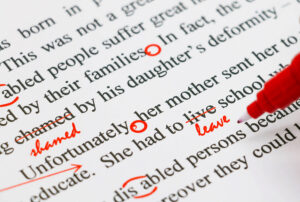
Before the editor, take time to eliminate a few obvious errors. Paying attention to the five tips listed in this week’s blog before the editor sees your manuscript makes a world of difference in the quality of edit you receive back.
When I must spend hours removing extraneous and overused words or correcting basic grammar errors, I have less time to make the work glow. Either that, or you end up paying far more for the edit. While I charge by the word, many editors charge by the hour. Consider how much money you can save by looking at a few things before the editor.
1. Before the editor, check common overused words.
I used to write that and just. A lot. Until someone pointed it out, I didn’t realize how many instances of those two words appeared in my documents. I once edited a book where these two words appeared 6,000 times (not exaggerating). My client paid for 6,000 words I deleted before looking at anything else. Significant savings, yes? In addition, I found numerous times the client use “so,” “even,” “well.” You get the picture. When reading through your manuscript, notice words that seem frequent. Sometimes, you use them throughout the book or article, although the word may appear only in one chapter and overall, you only used it ten times. Use the find functionality to check. Most of the time, you do not need these words, and while they may not bother a reader as much as an editor, they make me insane.
In my first articles, I often ran over my word limit. Removing repeated occurrences of several words tightened my writing. Do I still catch myself using them? SIGH. It happens, but far less than before I became aware of overusing them. Easy fix; take care of removing the unnecessary ones before the editor sees your work.
2. Correct common grammatical errors.
Nothing screams amateur like common errors. In the 1990s, the rule of two spaces at the end of a sentence changed. Yet I still see that error, especially with older clients. (By older, I mean anyone who learned typing before the mid-90s.) Commas get tricky, but that’s where you look at a style guide and learn the rules. Make sure to apply proper settings in your writing program (whatever you use) and let the computer notify you of mistakes. Before the editor, run a grammar and spell check program to capture the ones you missed. As humans, we all miss them, and sometimes, we need a little help from AI. You can use the built-in feature of Word at the least. Grammarly and, my favorite, ProWritingAid take the self-editing further and tend to identify more mistakes. When a manuscript includes less of these, your editor can focus on the more important aspects of your work.
3. Work to eliminate passive verbs.
To be or not to be… Better not to use passives. Sometimes unavoidable, most writing works better when you stay active. Kinda like life in general. When we stay active, we stay healthy. When you write active, you write stronger. Which gives more information? The ball was thrown to Tommy. His dad threw the ball to Tommy. Now, as an editor, I read the first sentence and think, passive. Need action. With the second sentence, I think, what if you use a stronger word than threw?
This personal pet peeve comes from a former life when I worked in the corporate world. After changing to a new department, a coworker and I received the task of writing standard operating procedures. I wrote many before that, but when my new manager read our first drafts, she made a statement I remember over ten years later. “Just because these are technical doesn’t mean they have to be boring. Lose the passives.” I returned to my desk, insulted, until I read the document again and realized I used far too many passive verbs.
We hear show, don’t tell. When I see passives, I see telling.
4. Watch for consistency.
I originally named characters in a novel Gertie, Frederick, and Harry. Gertie, my protagonist, changed to Trudy, and I used find/replace, so that worked well. However, I forgot the minor character names, and from early to late chapters caught the mistake during edits. If you question a character’s name, take time to go back and look.
Some spellings can go either way and come down to preference. But check for consistency before the editor gets the work. Toward or towards for example. I prefer the USA toward, but once you choose, avoid mixing them. Many words in the English language apply, and when unsure, check Merriam-Webster or your favorite dictionary.
5. Before the editor, read through your manuscript again.
By the time you finish the first draft, self-editing, and rewrites, you may not want to read it again. Ever. But read through one last time. If a section makes little sense to you, fix it. Look for obvious errors. Some of you want to say, “But I pay the editor to do this.” Yes, you do. I promise, an experienced editor will find more things you need to change, correct, or consider regardless of how much you self-edit. And when you take time for due diligence before the editor sees it, you get a stronger edit with deeper insights.
If I don’t need to look for these five things when editing, I clearly see places that improve, not simply correct your work. Which do you prefer? Sending a mediocre manuscript may get a good one returned, but if you send an already good manuscript, you end up with a fantastic one.
Level up with a little extra work before sending your manuscript to the editor.
Need help? A writer’s group can help.
